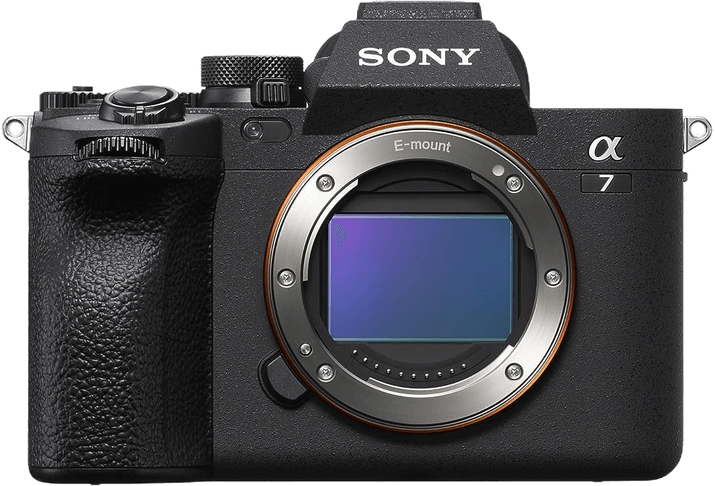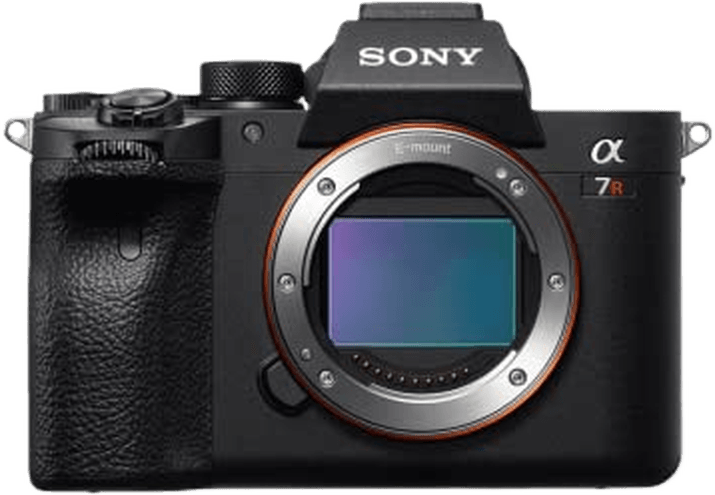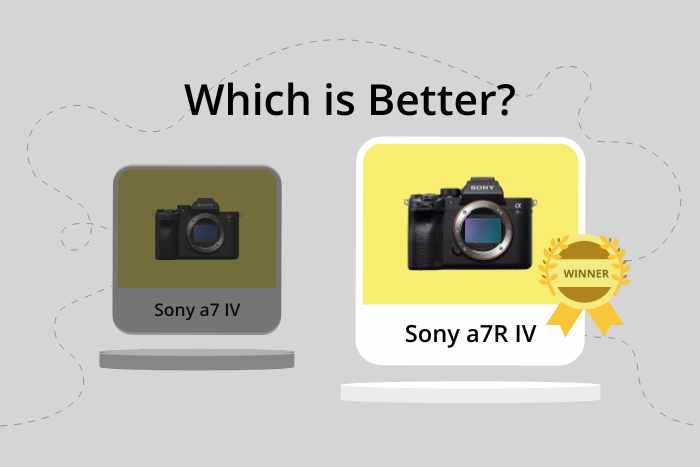Sony a7 IV vs a7R IV Comparison
Sony a7 IV

Sony a7R IV

The Sony a7 IV and Sony a7R IV both scored 84/100, making them equally impressive mirrorless cameras. They share similarities in size and weight, with the a7 IV measuring 131 x 96 x 80mm and weighing 659g, while the a7R IV measures 129 x 96 x 78mm and weighs 665g.
The a7 IV, released in 2021, has a launch price of $2499, making it more affordable than the a7R IV, which was released in 2019 and has a launch price of $3500. This price difference gives the a7 IV an advantage for those on a budget.
On the other hand, the a7R IV’s release in 2019 means it has had more time on the market, potentially benefiting from firmware updates and a larger user base for support.
Both cameras excel in their respective areas, with the a7 IV being a more budget-friendly option and the a7R IV having a longer presence in the market. Ultimately, the choice between these two cameras will depend on individual preferences and priorities.
Sony a7 IV vs a7R IV Overview and Optics
The Sony a7 IV and Sony a7R IV both score 85/100 in our optics comparison. These cameras share several key specifications, including a CMOS sensor, full-frame sensor size, Sony FE lens mount, 10 fps shooting speed, and image stabilization. Despite these similarities, there are notable differences in their performance.
The Sony a7R IV has a higher megapixel count at 61.2 compared to the Sony a7 IV’s 33 megapixels. This enables the a7R IV to capture more detail and produce higher-resolution images. Additionally, the a7R IV has a higher DXOMARK sensor score of 99, compared to the a7 IV’s score of 97. This shows that the a7R IV’s sensor performs better in terms of color depth, dynamic range, and low-light performance.
On the other hand, the Sony a7 IV has the advantage of a newer Bionz XR processor. This processor allows for faster and more efficient image processing, potentially resulting in improved performance in areas such as autofocus, noise reduction, and overall image quality.
Both cameras excel in their respective areas, with the Sony a7R IV offering superior image resolution and sensor performance, while the Sony a7 IV benefits from a more advanced processor. Ultimately, the choice between these two cameras depends on the individual’s priorities and needs. Photographers seeking the highest possible image quality and resolution may prefer the a7R IV, while those who prioritize processing speed and efficiency might lean towards the a7 IV. Either way, both cameras offer impressive optics performance that is sure to satisfy a wide range of users.
Sony a7 IV vs a7R IV Video Performance
The Sony a7 IV outperforms the Sony a7R IV in video capabilities, earning a score of 91 out of 100, compared to the a7R IV’s score of 70. Both cameras share some common specifications, including a maximum video resolution of 4K and dimensions of 3840 x 2160 pixels. Additionally, both models feature built-in time-lapse functionality, making them suitable for capturing stunning time-lapse sequences.
Despite these similarities, the Sony a7 IV surpasses the a7R IV in video performance, primarily due to its higher maximum video frame rate. The a7 IV can record at an impressive 120 frames per second (fps), enabling ultra-smooth slow-motion playback and more versatile creative options for videographers. This feature sets the a7 IV apart from the a7R IV, which only offers a maximum frame rate of 30fps.
While the a7R IV lags behind the a7 IV in terms of video frame rate, it may still be a suitable option for photographers who prioritize high-resolution still images over advanced video features. However, for those focused on capturing the best possible video quality, the a7 IV is the clear winner in this comparison.
Considering the significant difference in video scores and the superior frame rate offered by the Sony a7 IV, it is evident that this camera is better suited for videographers and those who require advanced video capabilities. On the other hand, the Sony a7R IV, while not a top performer in video, may still meet the needs of photographers focusing primarily on still images.
Sony a7 IV vs a7R IV Features and Benefits
The Sony a7 IV and Sony a7R IV both have a feature score of 83 out of 100, making them equally strong in terms of features. Both cameras share several specifications, including a 3-inch screen size, touchscreen capability, flip screen, absence of GPS, and the presence of WIFI and Bluetooth connectivity.
The Sony a7R IV stands out with its higher screen resolution of 1,440,000 dots, compared to the Sony a7 IV’s 1,040,000 dots. This difference results in a sharper and clearer display on the a7R IV, allowing for better image preview and easier menu navigation.
On the other hand, the Sony a7 IV does not have any specific features that make it superior to the a7R IV. Both cameras have the same score and share most of their specifications, indicating that they perform similarly in terms of features.
Taking these points into consideration, the Sony a7R IV’s higher screen resolution makes it a better choice for those who prioritize display quality. However, since both cameras have the same feature score and share most specifications, the choice between the two may depend on other factors such as price, individual preferences, and specific use cases.
Given the equal feature scores and shared specifications, both the Sony a7 IV and Sony a7R IV are strong contenders in the camera market. While the a7R IV has a slight advantage in screen resolution, the choice between these two cameras ultimately depends on the user’s individual needs and preferences.
Sony a7 IV vs a7R IV Storage and Battery
The Sony a7R IV outperforms the Sony a7 IV in storage and battery, scoring 79/100 compared to the a7 IV’s 76/100. Both cameras share common specifications, including two memory card slots, NP-FZ100 batteries, and USB charging capabilities.
The a7R IV takes the lead with a longer battery life of 670 shots, 90 more than the a7 IV’s 580 shots. This advantage allows for more extended shooting sessions without needing to replace or recharge the battery. However, the a7 IV accepts both CFexpress Type A and SD (UHS-II compatible) memory cards, providing more flexibility in storage options. The a7R IV only accepts SD / SDHC / SDXC (UHS-II compatible) memory cards.
Despite the a7 IV’s flexibility in memory card compatibility, the a7R IV’s superior battery life makes it the better choice for photographers who prioritize longer shooting times. The a7 IV, on the other hand, may appeal to those who value diverse storage options.
Sony a7 IV vs a7R IV Alternatives
Still not ready to make a decision? Check out our other popular camera comparisons for inspiration:

